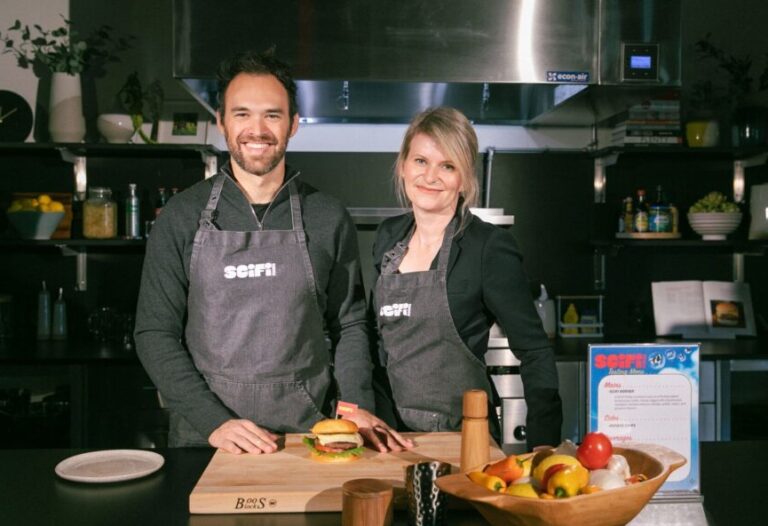Every entrepreneur sets out to build a successful company, say the founders of now-defunct cultivated meat startup SCiFi Foods. But only a fraction will succeed, and right now, they warn, we’re “at the precipice of a mass startup extinction… If you’re down to six months or less of runway with no term sheet, now is the time to start working on backup plans.”
Handle things well, say Joshua March (former CEO) and Dr. Kasia Gora (former CTO) in a white paper shared by Astera Institute, a nonprofit that supports science and technology projects, and you may achieve “somewhat positive outcomes like an acquisition or ‘acquihire’ that returns investor capital.”
Fail to get your ducks in a row, and you could face “abject failure involving lawsuits with personal liability or, worse still, professional disgrace,” say the pair, who raised $40 million from investors including Andreesseen Horowitz but ultimately ended up winding down through an ABC (Assignment for the Benefit of Creditors) process in June.
“Despite hitting all of our technical milestones,” they explain, “SCiFi Foods failed to raise a series B. And with venture debt on the books, we ran out of time to close an M&A transaction, leading us to wind down the company through an ABC process. We learned a lot, and knowing what we know now, there are several things we would have done differently…”
You can read the 20-page document about achieving a “graceful exit” in full, but here are a few key learnings they say emerged from their experience as a venture-backed deep tech startup with no revenue but some IP.
“Many companies raised large amounts of capital before VC funding significantly constricted in 2022 and are now near the end of their runway, and struggling to raise their next round. If yours is one of those companies, this guide is for you.” Joshua March and Dr. Kasia Gora, cofounders, SCiFi Foods
Manage stakeholders… and keep staff and investors informed
If you’re going out of business, say March and Gora, the quality of your stakeholder management is the “number one determinant of how gracefully your company fails.”
Above all, they note, “This is not the time for magical thinking and sugarcoating bad news. While those communication strategies can be effective as you try to grow your business, they are not useful for a wind-down situation.”
Once it became apparent that raising a series B at SCiFi Foods was unlikely, they explain, “The best-case scenario was getting acquired without most of the staff, and the worst-case scenario was wind down through ABC, which is exactly what we told our team. It was a hard conversation, but everyone appreciated the honesty.
“We worked to keep the team informed through weekly all hands and made it clear that we understood that some of them may start looking for other jobs, and it was OK to discuss this in the office. The result was that every remaining employee stayed with us until the end, and they continued being productive.”
Six months out: prepare for the worst
If you’re down to six months or less of runway with no term sheet, there are three options, they explain: A: raise more money; B: get acquired; and C: wind down the company.
In retrospect, they say, “We should have started the M&A process earlier. We only had four months to run our process, which was insufficient. That is because we waited until we were sure that fundraising was likely to fail before formally kicking off the process. Ideally, we would have run a dual fundraising and M&A process, which would have been harder to pull off regarding investor communication, but it could have yielded a better outcome.”
Extend runway with deeper cuts, sooner
When it comes to layoffs, one deep cut early may be preferable to a series of smaller cuts, meanwhile.
SCiFi Foods, for example, laid off 10-15% of staff about a year before closing up, followed by a 50% cut six months later. This, in hindsight, “was a mistake,” say March and Gora. “If we had the deeper cut sooner, we would have been just as productive while extending our runway by multiple extra months. We’ve heard the same thing multiple times from other founders.”
Handle layoffs professionally and respectfully
It probably goes without saying, but if you have to lay people off, they add, talk to an employment lawyer first to ensure you’re doing things correctly, communicate well, and move quickly: “Word will leak out somehow. As soon as it does, productivity will plummet, and people will start looking for other roles.”
And if you haven’t been communicating, they add, “Start today. Your remaining employees have chosen to stay on the bus, and they deserve to know the challenges and obstacles you face on the road.
“Be clear this is a layoff, and they are not being fired for cause, meaning they are eligible for unemployment and COBRA [a scheme allowing former employees to temporarily keep health coverage] while the company remains solvent. You should have severance documents ready and offer reasonable severance (usually two weeks) in return for a waiver.”
Another way of extending runway is to enact a so-called ‘hibernation’ strategy by keeping your startup in a state of suspended animation with a skeleton crew until market conditions become more favorable, they observe. But it’s risky.
“If this will enable you to reach an inflection point that changes the company’s momentum, it can be worth pursuing. However, if no inflection point comes until you’re able to raise more capital, trying to raise off the back of zero growth or momentum is incredibly hard.”

Three months out: budget for closing down the business
By the time you get to three months to cash out, say March and Gora, you should have a comprehensive budget for closing down the business which includes everything from paying out employee PTO, to D&O (directors and officers) insurance, and all professional services costs involved in executing the wind down.
“At SCiFi Foods, we almost got into trouble when it turned out our quote for the ABC process was only the fees for the advisory firm, and the full budget was more than twice the cost,” they reveal. “Luckily we discovered this in time to adjust our budget and cover everything necessary, but if we’d found out just a week later, it could have been a huge problem.”
Endgame: Wind down, file for bankruptcy, or pursue an ABC process
If you have enough cash in the bank to pay off creditors and no IP or assets because you’ve sold them already or you have none, you can simply wind down the company with the help of a law firm or startup such as SimpleClosure, they explain.
If you don’t have enough cash to pay off your liabilities, an ABC process can provide advantages over bankruptcy, they add.
“In an ABC process, you appoint an advisory firm to handle the sale of your IP and assets and distribution to creditors and shareholders, giving you more control over the process.”
SCiFi, for example, worked with Sherwood Partners, which ran a formal auction process to sell its IP, equipment and other miscellaneous assets, managed its creditors and handles all the legal issues related to the sale and wind down.
Intellectual property
Ideally, you can get your intellectual property into the public domain, they say. At a minimum, you can work to ensure it goes to competitors. “As SCiFi Foods was nearing an end, and through the ABC process, we were able to arrange for a nonprofit to acquire our primary IP, in our case cell lines, to make them open access for future startups.”
Read the full document: ‘Graceful Exit: Navigating the Complexities of Winding Down a Deep Tech Venture.’
Further reading:
BREAKING: Cultivated meat co SCiFi Foods closes up shop, appoints firm to run sales process
Cultivated meat is down but not out, says meat industry veteran and new CEO at Meatable
Tufts professor has ‘zero worries’ about long-term viability of cultivated meat
UPSIDE Foods initiates new round of layoffs as state lawmakers take aim at cultivated meat
















